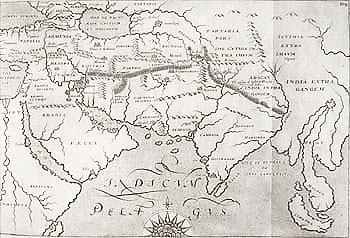For a writer of history, Noah’s Ark was not so much a stimulus to geometry, natural history or biblical exegesis, as a critical episode in the unfolding destiny of man. Thus, one of Ralegh’s main concerns is the resting place of the Ark, since it was from here that men and animals re-colonized the earth. He also used the Ark to illustrate several of the themes that animate his concern with the patriarchal age. They relate for the most part to the decline of man and nature. So long as the earth retained something of the vigour of God’s creation, the patriarchal life-span was long. Now ‘time it selfe (vnder the deathfull shade of whose winges all things decay and wither) hath wasted and worne out that liuely vertue of Nature in Man, and Beasts, and Plants’, and we in the old age of the world are reduced to compensating for nature’s deficiencies with ‘the artificiall helpe of strong waters, hot spices, and prouoking sawces’ (p. 77).
But some geometry is inevitably part of the story and Ralegh has an extended taxonomy of cubits, which includes the large ‘geometrical’ cubit other authors invoked to increase the size of the Ark. This tradition derived from Origen, who held that Moses, since he lived in Egypt, would have used the geometrical cubit of Egyptian measure, which was six times as long as the common one. Ralegh, however, follows Buteo (catalogue no. 27 ) in his opinion that the common cubit of 18 inches will suffice for the animals Noah had to accommodate. The larger men of the patriarchal age would require, it is true, more space, but since the cubit was the distance from a man’s elbow to the tip of his middle finger, the unit of length was also greater ‘according to the measure of Giantly stature’ (p.112). Although all of Nature’s progeny, including animals, was larger, we can be sure, by applying the golden rule of proportional calculations, that if an ark measured by our reduced and wasted cubit seems sufficient for the decayed state of the natural world, Noah’s Ark will have held the men and animals of that more vigorous age: ‘… it followeth of necessitie, that those large bodies which were in the daies of Noah might haue roome sufficient in the Arke, which was measured by a Cubit of length proportionable’ (p.112).

|
|
Ralegh attributed to Noah knowledge of the motions and nature of the heavens, a science passed through Noah’s sons to Zoroaster. But he was also remarkably well informed on recent astronomical discoveries, presumably through the agency of Thomas Harriot. Ralegh sought to separate Noah’s Flood from the flood ‘in the time of Ogyges’, and to deny the miraculous nature of the latter. The pagan story of the flood of Ogyges and its relationship to the story of Noah was a problem for biblical commentators, as was that of the later flood of Deucalion, which Deucalion survived with his wife by floating in a large chest. Ralegh adds to this discussion by explaining reported changes in the appearance of Venus. That these were not miraculous portents could be deduced from the observations of Galileo, published in the Letters on Sunspots of 1613, the year before Ralegh’s Historie: ‘Galilæus, Galilæus, a worthy Astrologer now liuing, who by the help of perspectiue glasses haue found in the starres many things vnknown to the ancients, affirmeth so much to haue beene discovered in Venus by his late obseruations’ (p.100). Galileo had observed the phases of Venus using a telescope, but an equivalent optical effect might have been produced by the mists and fogs associated with the onset of a flood.
There are many references to Ralegh’s Historie in Hartlib’s Ephemerides. At one point Hartlib compares three English literary statesmen, Thomas More, Francis Bacon and Ralegh: ‘More was a States-man and divine Verulam a States-man and Philosopher but Raleigh a States-man and a Souldjer. The 2. former the likelier honest-men’ (Hartlib Papers, 28/1/19B–20A [Ephemerides, 1649]). |




